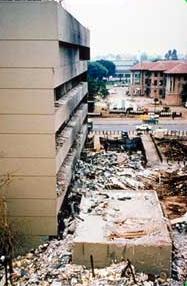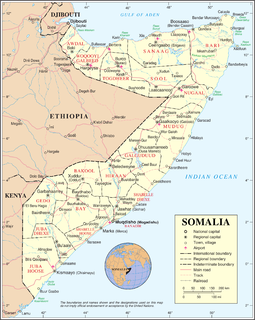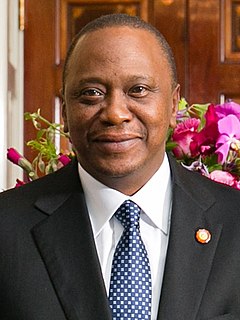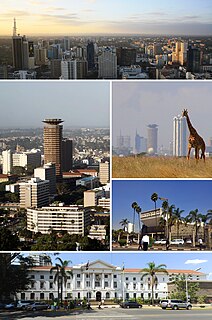The following lists events that happened during 2007 in Kenya.
The earliest account of Nairobi's history dates back to 1899 when a railway depot was built in a brackish African swamp occupied only by a pastoralist people, the Maasai, as well as the agriculturalist Kikuyu people who were both displaced. The railway complex and the building around it rapidly expanded and urbanized until it became the largest city of Kenya and the country's capital. The name "Nairobi" comes from the Maasai phrase Enkare Nyirobi, which translates to "the place of cool waters". However, Nairobi is popularly known as the "Green City in the Sun."

There is a high rate of crime in all regions of Kenya, particularly in Nairobi, Mombasa, Kisumu, and coastal beach resorts. There are regular reports of attacks against tourists by groups of armed assailants. However, the most common crime in Kenya is carjacking so the criminal can commit an armed robbery. "Snatch and run" crimes are becoming more common on city streets.
A list of happenings in 2009 in Kenya:
A list of happenings in 2010 in Kenya:

This is a 2011 timeline of events in the War in Somalia (2009–present).
Since late 2011, Kenya has seen an upsurge in violent terrorist attacks. Kenyan government officials asserted that many of the murders and blasts were carried out by Al-Shabaab in retaliation for Operation Linda Nchi, a coordinated military mission between the Somalian military and Kenyan military that began in October 2011, when troops from Kenya crossed the border into the conflict zones of southern Somalia. According to Kenyan security experts, the bulk of the attacks were increasingly carried out by radicalized Kenyan youth who were hired for the purpose. Kenya security officials also indicated that they were part of death squads, which carried out many of the killings under the orders of a government security council. By mid-2014, the cumulative attacks began affecting Kenya's tourism industry, as Western nations issued travel warnings to their citizens.
The following is a timeline of the history of the city of Nairobi, Kenya.
Kenya has been the scene of various attacks attributed to terrorist elements. In 1980, the Jewish-owned Norfolk hotel was attacked by the Palestine Liberation Organization (PLO). In 1998, the US embassy in Nairobi was bombed, as was the Israeli-owned Paradise hotel in 2002. In 2013, the militant group Al-Shabaab killed 67 people at Nairobi's Westgate Shopping Mall. There have been numerous other lesser attacks.
Somali-Kenyan conflict within Kenya has been a consistent issue since the colonial period. Problems have ranged from petty skirmishes between the two communities, to police harassment, extortion, home invasions, physical violence, and massacres perpetrated against the Somali-Kenyan community.

On Saturday, 21 September 2013, four masked gunmen attacked the Westgate shopping mall, an upscale mall in Nairobi, Kenya. There are conflicting reports about the number killed in the attack, since part of the mall collapsed due to a fire that started during the siege. The attack resulted in 71 total deaths, including 62 civilians, five Kenyan soldiers, and four attackers. Approximately 200 people were wounded in the mass shooting.
On 4 May 2014, two improvised explosive devices exploded on buses in Nairobi, Kenya, killing three people and injuring sixty-two. Both of the bombs exploded northeast of Nairobi on the Thika Road, an eight-lane controlled-access highway, and detonated 1 kilometre (0.62 mi) apart. Twenty of the wounded were in critical condition after the blast.

On 2 April 2015, gunmen stormed the Garissa University College in Garissa, Kenya, killing 148 people, and injuring 79 or more. The militant group and Al-Qaeda offshoot, Al-Shabaab, which the gunmen claimed to be from, took responsibility for the attack. The gunmen took over 700 students hostage, freeing Muslims and killing those who identified as Christians. The siege ended the same day, when all four of the attackers were killed. Five men were later arrested in connection with the attack, and a bounty was placed for the arrest of a suspected organizer.

This is a 2016 timeline of events in the War in Somalia (2009–present).
The 2019 DusitD2 complex attack was a terrorist attack that occurred from 15 to 16 January 2019 in the Westlands area of Nairobi, Kenya, which left more than 20 people dead.









